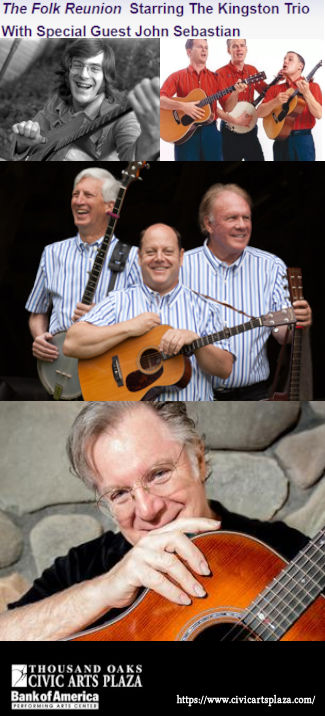
 Over the weekend, we had the opportunity to go the Kavli Theatre in Thousand Oaks (FB) to see what was being sold as a “Kingston Trio” concert, but was really what was called a “Folk Reunion. What this meant was that there were two groups: The first act was John Sebastian (FB) (of the Loving Spoonful, as well as his solo career); the second act was the current incarnation of what is called the “Kingston Trio” (FB) (but which contains none of the original Trio members). Owing to a migraine, I didn’t note any setlists.
Over the weekend, we had the opportunity to go the Kavli Theatre in Thousand Oaks (FB) to see what was being sold as a “Kingston Trio” concert, but was really what was called a “Folk Reunion. What this meant was that there were two groups: The first act was John Sebastian (FB) (of the Loving Spoonful, as well as his solo career); the second act was the current incarnation of what is called the “Kingston Trio” (FB) (but which contains none of the original Trio members). Owing to a migraine, I didn’t note any setlists.
John Sebastian opened the show with a one-hour reminiscence, starting with stories of Mississippi John Hurt. I was familiar with John Hurt from Tom Paxton’s shows; I had no idea that Sebastian was also influenced in his guitar stylings from him. Such an influential man. He basically told the story chronologically of how he entered into folk music, and how the Spoonful got started — again, demonstrating the importance of the Greenwich Village NY scene to the folk revival. Along the way, he did representative tunes and a number of his hits, most of which I was familiar with (I wasn’t familiar with his theme song for the Care Bears, and alas he didn’t do “That’s Cat“). But he did do other Spoonful hits, and I found his history lesson quite enjoyable.
After the intermission, the Trio came on. John Sebastian was the real guy — the original who had been there at the birth. The Trio, on the other hand, was just the latest incarnation. If you read the history of the Trio on Wikipedia, you’ll know that — just like the Limeliters — they went through a number of incarnations over their history, to the point where the group performing has the sound and the shirts, but not the history. The original Trio was Dave Guard, Bob Shane, and Nick Reynolds. Disagreements in the group led to Guard leaving and being replaced with John Stewart. That configuration lasted until a hiatus in 1967. A “New Kingston Trio” was later formed by Bob Shane with a number of different artists over the years. In 1976, they were able to drop the “New”, and the KT was Shane, Roger Gambill, and George Grove, and after Gambill died, there were a number of configurations.
The Trio that we saw was the latest version, and consisted of Josh Reynolds, who is the son of Nick Reynolds, a founding member of the band, his cousin Gerald “Mike” Marvin, and Tim Gorelangton. This configuration, after some legal kerfuffles, started performing in October of this year.
Now to true Folkies like me, the Kingston Trio is … problematic. They are one of the few groups responsible for the growth of folk music in the late 1950s — it was their success that led to folks like Tom Paxton, Peter Paul and Mary, The Brothers Four, the Chad Mitchell Trio and many others. They had a sound and an energy that was infectious. However, they also were not folk purists. They changed lyrics, often for the worse (you should hear what they did to Oleanna). They butchered the story of Tom Dula into Tom Dooley. They claimed royalties on traditional songs. All of this is noted in the Wikipedia entry. But, as they say in Urinetown: the music — it’s so good. They have an energy and a fun that makes you forget all that pesky history and tradition.
The current Trio — Reynolds, Marvin, and Gorelangton — have the musical craft down. They know the old songs and the old routines and the pacing (although a few of the songs seem speeded up a little, in particular, “Scotch and Soda”). They know the hits the audience wants to hear. They still get things wrong — they introduced the Ballad of the Shape of Things as an old English Madrigal, when it is nothing of the sort: It was also written by Sheldon Harnick (for the Littlest Revue), just like the Merry Minuet (which they also did). They are just fun to watch and have a lot of fun on stage.
But they are not the real Trio. They are an enjoyable facsimile, a generation once removed. When you put them with the real history that is Sebastian, there is no comparison. As Tom Paxton said about nostalgia: It’s OK to look back, as long as you don’t stare. With these two groups, you looked back, but you stared for different reasons.
***
Ob. Disclaimer: I am not a trained theatre (or music) critic; I am, however, a regular theatre and music audience member. I’ve been attending live theatre and concerts in Los Angeles since 1972; I’ve been writing up my thoughts on theatre (and the shows I see) since 2004. I do not have theatre training (I’m a computer security specialist), but have learned a lot about theatre over my many years of attending theatre and talking to talented professionals. I pay for all my tickets unless otherwise noted. I am not compensated by anyone for doing these writeups in any way, shape, or form. I currently subscribe at 5 Star Theatricals (FB) [the company formerly known as Cabrillo Music Theatre (FB)], the Hollywood Pantages (FB), Actors Co-op (FB), the Chromolume Theatre(FB) in the West Adams district, and a mini-subscription at the Saroya [the venue formerly known as the Valley Performing Arts Center (VPAC)] (FB). Through my theatre attendance I have made friends with cast, crew, and producers, but I do strive to not let those relationships color my writing (with one exception: when writing up children’s production, I focus on the positive — one gains nothing except bad karma by raking a child over the coals). I believe in telling you about the shows I see to help you form your opinion; it is up to you to determine the weight you give my writeups.
Upcoming Shows:
Next weekend brings a Day Out with Thomas at Orange Empire Railway Museum (FB), as well as The Kingston Trio (FB) at the Kavli Theatre in Thousand Oaks (FB). The third weekend will bring Edges at the CSUN Theatre Department (FB) on Friday, the Tumbleweed Festival (FB) on Saturday, and Spamilton at the Kirk Douglas Theatre (FB) on Sunday. Thanksgiving Weekend will bring Something Rotten at the Ahmanson Theatre (FB). November concludes with the Anat Cohen Tentet at the Saroya (the venue formerly known as the Valley Performing Arts Center (VPAC)) (FB) and Levi (a new Sherman Brothers musical) at LA Community College Caminito Theatre (FB).
December starts with ACSAC 2017 in Orlando FL. As soon as we return, we’ve got Pacific Overtures at Chromolume Theatre (FB) and the Colburn Orchestra at the Saroya (the venue formerly known as the Valley Performing Arts Center (VPAC)) (FB). The weekend encompassing Chanukah sees us back at the Saroya (FB) for the Klezmatics (FB). We also hope to squeeze in a performance of A Christmas Story at the Canyon Theatre Guild (FB). Of course there will also be the obligatory Christmas Day movie.
Right now, early 2018 is pretty open, with only a few weekends taken by shows at the Pantages and Actors Co-Op. I did just pick up tickets for Candide at LA Opera (FB). But that will likely fill up as Chromolume announces their dates, and announcements are received on interesting shows. Currently, we’re booking all the way out in mid to late 2018!
As always, I’m keeping my eyes open for interesting productions mentioned on sites such as Better-Lemons, Musicals in LA, @ This Stage, Footlights, as well as productions I see on Goldstar, LA Stage Tix, Plays411 or that are sent to me by publicists or the venues themselves. Note: Lastly, want to know how to attend lots of live stuff affordably? Take a look at my post on How to attend Live Theatre on a Budget.
 One of the categories in which I collect news chum is titled “Music and iPod”. The articles I’ve collected here fall into two broad categories. The first looks at the changing music marketplace. The second collects information on potential iPod replacements. So unlock your device, take your scroll-wheel for a spin, and let’s start.
One of the categories in which I collect news chum is titled “Music and iPod”. The articles I’ve collected here fall into two broad categories. The first looks at the changing music marketplace. The second collects information on potential iPod replacements. So unlock your device, take your scroll-wheel for a spin, and let’s start.

 Ah, Thanksgiving is over. People can start putting up their holiday decorations, and oh the shopping at those Black Friday sales. Have we got a bargain for you here on this blog: A sale on some slightly used news chum, cleaning out the inventory with a Thanksgiving and Black Friday theme. Shall we start?
Ah, Thanksgiving is over. People can start putting up their holiday decorations, and oh the shopping at those Black Friday sales. Have we got a bargain for you here on this blog: A sale on some slightly used news chum, cleaning out the inventory with a Thanksgiving and Black Friday theme. Shall we start?
 Over the weekend, we had the opportunity to go the
Over the weekend, we had the opportunity to go the  I’m home today with a cold, and I have loads of interesting news chum links that have no coherent theme, so let’s just get them out there (h/t to Andrew Ducker for a few of these). Oh, and with each, you’ll get a little bit more.:
I’m home today with a cold, and I have loads of interesting news chum links that have no coherent theme, so let’s just get them out there (h/t to Andrew Ducker for a few of these). Oh, and with each, you’ll get a little bit more.: I spent today recording LPs to my iPod (over 39,000 songs now!). A question came to mind: What do artists like Elvis Presley, Roger Whittaker, Theo Bikel, Chet Atkins, Al Hirt, Herb Alpert, Barbra Streisand, and Frank Sinatra all have in common. They are cover artists, not singer-songwriters performing material that they have written themselves. At one time, the cover artist was the main artist: others did the writing, they did the performing. That changed in the 1960s, thanks to duos like Lennon-McCartney.
I spent today recording LPs to my iPod (over 39,000 songs now!). A question came to mind: What do artists like Elvis Presley, Roger Whittaker, Theo Bikel, Chet Atkins, Al Hirt, Herb Alpert, Barbra Streisand, and Frank Sinatra all have in common. They are cover artists, not singer-songwriters performing material that they have written themselves. At one time, the cover artist was the main artist: others did the writing, they did the performing. That changed in the 1960s, thanks to duos like Lennon-McCartney. Some passings (or soon to be passings) from the last week that are worthy of note:
Some passings (or soon to be passings) from the last week that are worthy of note: